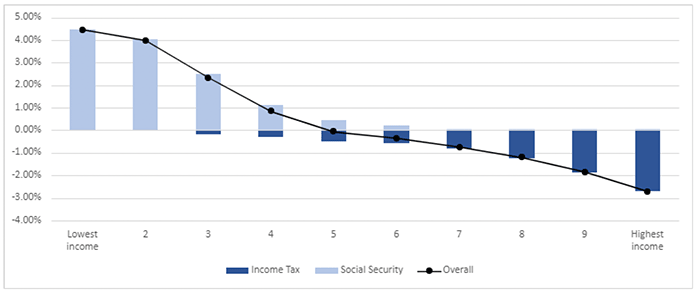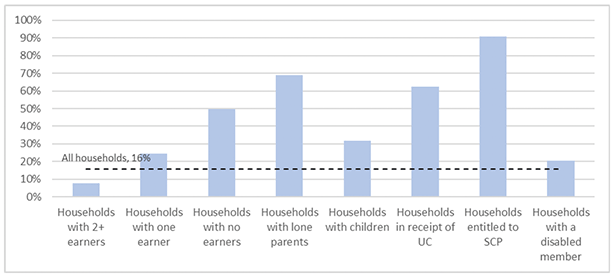The Scottish Government's Medium-Term Financial Strategy
This is the sixth Medium-Term Financial Strategy (MTFS) published by the Scottish Government and provides the context for the Scottish Budget and the Scottish Parliament.
Annex E: Distributional Analysis Methodology
This Annex sets out details of the assessment of the distributional impact of the Scottish Government's Income Tax and social security policy choices since the devolution of these powers following the Scotland Act 2016.
The analysis considers the impact of Income Tax and social security policy changes on households across the income distribution. The analysis takes into account the number of people in the household, its composition, and interactions with the wider (UK and Scottish) tax and benefit system. In doing so, it extends previous analysis as part of the 2023-24 Budget in December, which looked only at Income Tax policy. This analysis showed that Income Tax policy in Scotland continues to be progressive, with higher income households proportionately contributing the most. Extending the analysis to include decisions on social security provides a broader understanding of the distributional impacts of overall Scottish Government policy. However, it is important to note that changes to social security policies are not funded directly by Income Tax policies.
There are a number of challenges in understanding the impact of policy on households. Distributional models do not automatically capture any behavioural responses that may also affect incomes, and small sample sizes mean that it is often not possible to capture the impact of policies on particular protected characteristics, such as race.
Methodology
The analysis has been produced in UKMOD, an open-access microsimulation model developed by the Institute for Social and Economic Research (ISER) at the University of Essex. The model applies tax and benefit rules to a set of individual and household-level data, allowing the user to simulate and compare alternative scenarios.
The input data in UKMOD is derived from DWP's Family Resources Survey (FRS). The analysis in this report uses three years of FRS data, namely 2016-17, 2017-18, and 2018-19.[47] To pool the data, the grossing weights used to scale the FRS sample to the whole population are divided by the number of data years, in this case three. The income components and other monetary variables from each year of data to 2023-24 are taken from a range of sources, including historical data and forecasts by the Office for Budget Responsibility (OBR), but no adjustments are made for demographic change.
Tax parameters
The analysis compares tax liabilities across the different income deciles under the 2023-24 policy proposal, as set out in the Scottish Budget, compared to the rates and bands in England and Northern Ireland. These tax parameters are summarised in Table E.1.
| Scottish policy 2023-24 | Counterfactual scenario | ||
|---|---|---|---|
| Band | Rate | Band | Rate |
| £12,571 - £14,732 | 19% | £12,571 - £50,270 | 20% |
| £14,733 - £25,688 | 20% | ||
| £25,689 - £43,662 | 21% | ||
| £43,663 - £125,140 | 42% | £50,271 - £125,140 | 40% |
| Above £125,140 | 47% | Above £125,140 | 45% |
Social security parameters
The modelled social security benefits include the following:[48]
- Scottish Child Payment: a £25 weekly payment to eligible families;[49]
- Discretionary Housing Payment: a payment to support people with housing costs.[50] The Scottish Government is using DHPs to mitigate the bedroom tax and benefit cap.
- Carers Allowance Supplement: two lump sum £271.50 payments to recipients of Carers Allowance;[51]
- Best Start Grant and Best Start Foods: a range of payments made to eligible families.[52]
Benefits such as Free School Meals or the School Clothing Grant are not included in the analysis.
Results
Figure E.1 below shows the combined impact of our Income Tax and social security policies on household incomes in Scotland, compared to the system in the rest of the UK, and shows clearly that the Scottish Government's tax and social security policies are reducing inequality and targeting support at those who need it most. Scottish Government policies mean that household incomes increase by around 4% for households in the lowest and second lowest deciles and around 3% in the third.
The majority of this increase is due to Scottish Child Payment which gives £25 per week per child to families on low incomes and is a key part of delivering on our commitment to reduce child poverty with smaller contributions from other benefits such as Discretionary Housing Payment and Best Start Grant.

Source: Scottish Government analysis using UKMOD. Change in equivalised household disposable income before housing cost
An alternative way of looking at the analysis is by household type. Figure E.2 below shows the proportion of people who receive more than a 1% increase in income as a result of Scottish Income Tax and social security policies. Since the increase to people's incomes mainly comes from Scottish Child Payment (SCP), a higher than average proportion of people in households with lone parents (70%), households with children (over 30%) and households entitled to SCP (over 90%) are affected. Whereas a less than average proportion of people in households with more than two earners (almost 10%) are affected. This is because households with more than two earners are less likely to be entitled to means tested benefits and more likely to pay more Income Tax.

Source: Scottish Government analysis using UKMOD. Change in equivalised household disposable income before housing costs
Note: The scenarios do not assume full UC roll-out. 'Households in receipt of UC' does not include those currently in receipt of the legacy benefits. 'Households entitled to SCP' is based on household characteristics reflecting entitlement rather than receipt of SCP.
Looking ahead, we will continue to monitor the impact of tax and social security policies on households, and we will aim to incorporate other Scottish Government policies such as Free School Meals and the School Clothing Grant in our distributional analysis.
Contact
Email: sophie.osborn@gov.scot
There is a problem
Thanks for your feedback